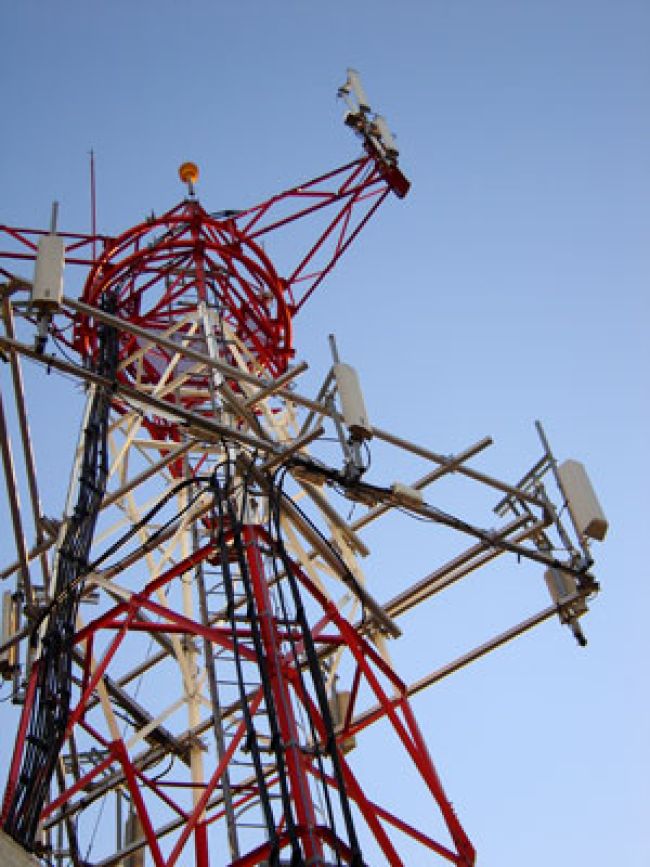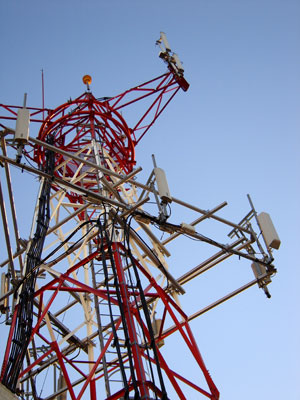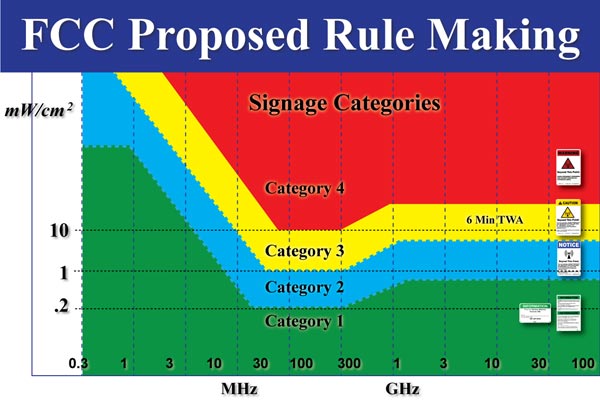
RF Safety for Utility Workers

Utility workers could be exposed to radiofrequency (RF) radiation every day and not even be aware of it. With today’s telecommunications explosion, even utility poles are housing cellular systems such as antennas and distributed antenna systems. And yet, the rapid growth rate of RF technology does not change the fact that we are still obligated to follow the laws and comply with OSHA and Federal Communications Commission (FCC) requirements, especially when dealing with RF radiation exposure limits.
Required Training
Not surprisingly, training is the best route to both RF safety and rule compliance. Anyone who enters a telecom tower site, or who works around antennas located on or near utility poles and building rooftops, must have received training that meets the requirements of OSHA 29 CFR 1910.268(c), and they must also be properly protected from any RF radiation emitted from antennas. Appropriate RF safety training will teach workers to recognize RF radiation hazards and control their exposure.
Unfortunately, many utility workers have not yet been fully trained in RF safety because their employers do not realize the training requirements nor the true dangers of RF radiation. Whatever the case, now is the best time to ensure workers complete training. They must know what they could be potentially exposed to and how to protect themselves. In fact, in the FCC’s June 4, 2013 final rule (see www.gpo.gov/fdsys/pkg/FR-2013-06-04/pdf/2013-12716.pdf), the commission states that individuals “must receive written and/or verbal information and notification (for example, using signs) concerning their exposure potential and appropriate means available to mitigate their exposure.” Additionally, the FCC stated, individuals exposed as a consequence of their employment must have appropriate training regarding work practices that will ensure that that they are “fully aware of the potential for exposure and can exercise control over their exposure.” The update goes on to note that education is the key to a successful RF compliance program.
Allowable Exposure and Potential for Danger
The FCC currently cites two levels of radiation exposure: controlled and uncontrolled. In the 2013 final rule, readers will note that the commission allows exposure and, on page 33651, states, “General population/uncontrolled exposure limits apply in situations in which the general public may be exposed, or in which persons who are exposed as a consequence of their employment may not be fully aware of the potential for exposure or cannot exercise control over their exposure.”
To put it simply, locked doors and signage are not enough to prevent RF radiation exposure. If someone is not fully aware of RF radiation dangers and cannot control his or her exposure, yet he or she has access to a site where exposure may be possible, the FCC considers this an uncontrolled area and the uncontrolled standard applies. Some people who may fall into this category include utility crew members, maintenance personnel, roofers and building managers.
The FCC maximum permissible exposure chart shown below has two levels: occupational/controlled and general population/uncontrolled. Those who work in RF fields likely see this chart often. The 30- to 300-MHz frequency range is the most stringently regulated, as the frequency waves in this range more closely resemble the height of a human and, therefore, absorption is easier/faster. All you need to know about this chart is what percentage of the standard you are exposed to. If you are trained and can exercise control over your exposure, you can be exposed to up to 100 percent of the standard and work in that area all day. If you are not trained, you can only be exposed to 20 percent of the controlled standard, represented by the green area (Category 1) in the chart.

I often hear, “Well, I won’t be in an area where RF is above the uncontrolled limit.” The key thing to remember is the potential to exceed this limit. If you are on a transmitter site, there is the potential for RF to be over the uncontrolled levels. RF radiation is a physical hazard, so OSHA expects a plan to be in place, training to have been done and personal protection monitoring to be in use. Monitoring is discussed a little later in this article.
Workplace Hazards and Federal Regulations
Workers who enter a telecommunications site must be trained to recognize that signage in a potentially hazardous area may refer to RF by a number of other names, including electromagnetic emissions (EME), radiofrequency emissions (RFE), radiofrequency radiation (RFR) or non-ionizing radiation. These all mean the same thing. OSHA requires annual training in non-ionizing radiation and has put forth regulations defining training requirements in 1910.268(c). The administration also lists RF radiation as a harmful physical substance in standard 1910.1020.
In response to this danger, OSHA requires right of access to exposure records if an employee is subjected to a toxic substance or harmful physical agent. These records, or hazard assessments, include the level of RF exposure to which the employee was subjected. By law, employers are required to inform all employees of such hazards upon their initial employment and at least annually thereafter or when modifications are made. A workplace hazard assessment will determine if hazards are present and determine the appropriate signage and personal protective equipment (PPE) to be used in the area. All transmitting facilities and devices regulated by the FCC are expected to comply with the appropriate RF radiation exposure guidelines.
The U.S. Department of Labor, which includes OSHA, mandates ongoing and yearly sampling to prove exposure-level compliance. Yearly sampling is required because changes can occur in building structures from year to year. All of the following can affect radiation: removal of shields/guards, detuning, leaks, dye changes, line speed variations, new equipment, grounding, element changes, ambient condition changes, voltage changes, peak loads and other process changes.
Personal Protection Monitors
For personnel who work on or near antennas, annual training is the minimum, but it may not be enough to guarantee hazard recognition and proper use of PPE. Personal protection monitors are critical to any fully functioning RF safety plan. Monitors must have a wide frequency range to ensure coverage at all potential frequencies. Monitors should also be isotropic, and – as simple as this sounds – it’s important that they are used correctly. Employees must receive monitor training before use and be deemed competent and qualified to use the monitors.
Best management practices dictate that the RF personal protection monitor takes precedence over all other precautions, such as signage and barriers. A monitor takes real-time readings; signage and barriers, on the other hand, were put in place using previously determined RF levels. Those levels could be up to a year old or even older if the workplace is noncompliant. Remember that things can change quickly on telecom sites. Additionally, there is no standard signage policy, so different FCC licensees post signs in different ways. Many times you will see an entrance door with several signs. It can be difficult to tell which sign is correct, and that is why the personal protection monitor is critical.
Use of monitors requires proper training of personnel, and OSHA reminds us that a monitor does not protect workers from a hazard; it only provides a means of warning. An RF safety monitor can be a useful tool, but it may give you a false sense of security. You should never totally rely on a monitor; instead, you must use it in conjunction with your knowledge of RF safety.
Be aware that high RF levels can interfere with the signals of communication equipment, thereby affecting the ability to communicate with other team members. They can also interfere with backup sensors and reverse video monitors, which can potentially lead to accidents. In a 2013 memorandum to all regional administrators, James Maddux, OSHA’s director of construction, stated that, when recording communications tower incidents, it’s important to find out if ambient RF was present and if employees were wearing any measuring or warning devices to protect against ambient RF.
In closing, always remember that RF is a very real and present danger to workers in the field. Knowledge is power, and training and following safe RF practices is critical.
About the Author: Miranda Allen is a safety professional who serves as CEO of Radiofrequency Safety International (www.rsicorp.com). A published author and national speaker, she is a passionate safety advocate who has been involved with RF safety for nearly 20 years. Allen has delivered RF safety training to thousands of people and has helped ensure compliance on tens of thousands of RF sites across the U.S. She serves on the National Association of Tower Erectors’ Member Services Committee and is a member of the American Society of Safety Engineers.
*****
Additional RF Safety Resources
Risk program managers should review IEEE Standard 1654 – currently under revision by ESMOL – which addresses RF protection for personnel, as well as the IEEE Standard C95.x series developed by the International Committee on Electromagnetic Safety. Canadian and other readers outside the U.S. should review documents published by the International Commission on Non-Ionizing Radiation Protection.

